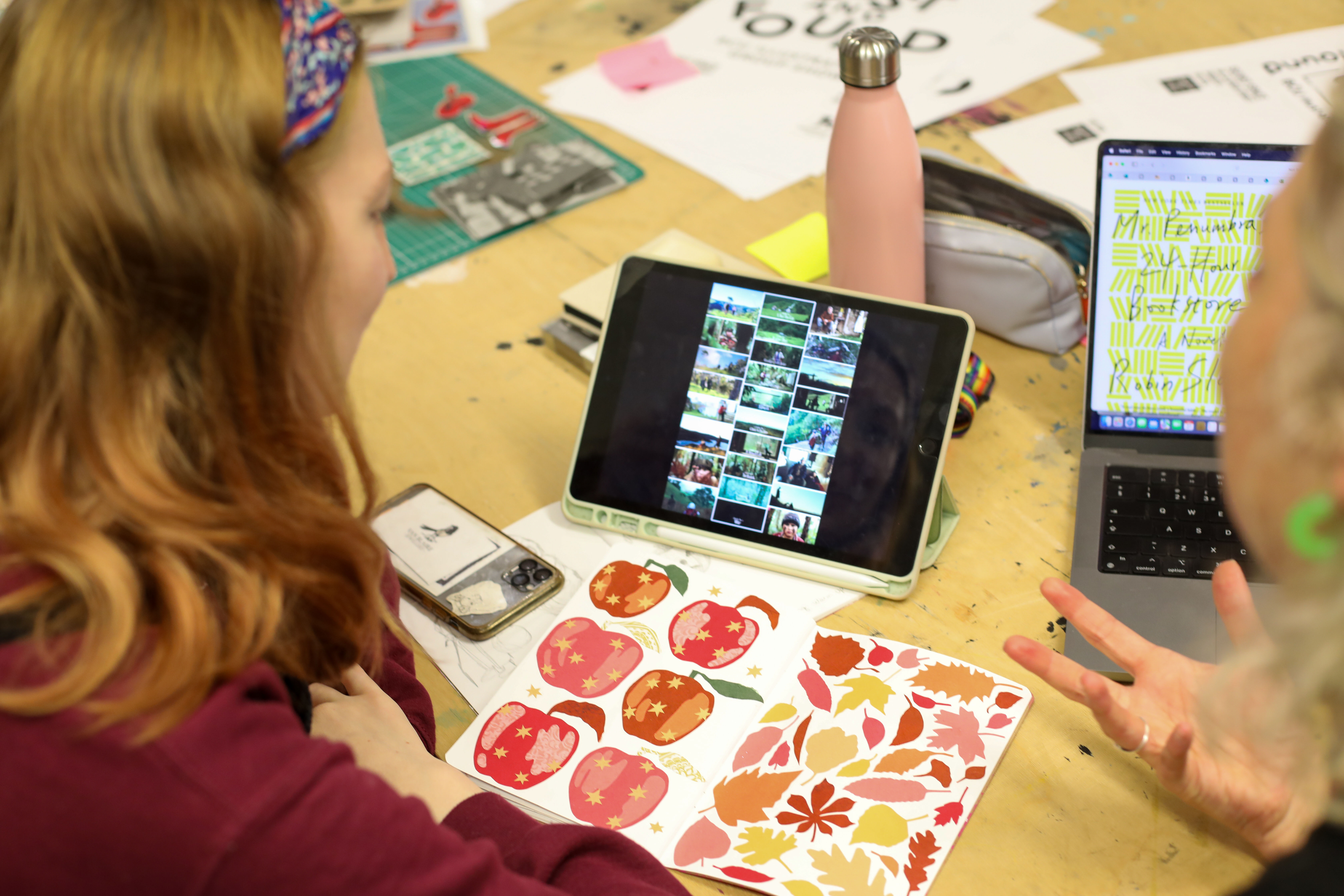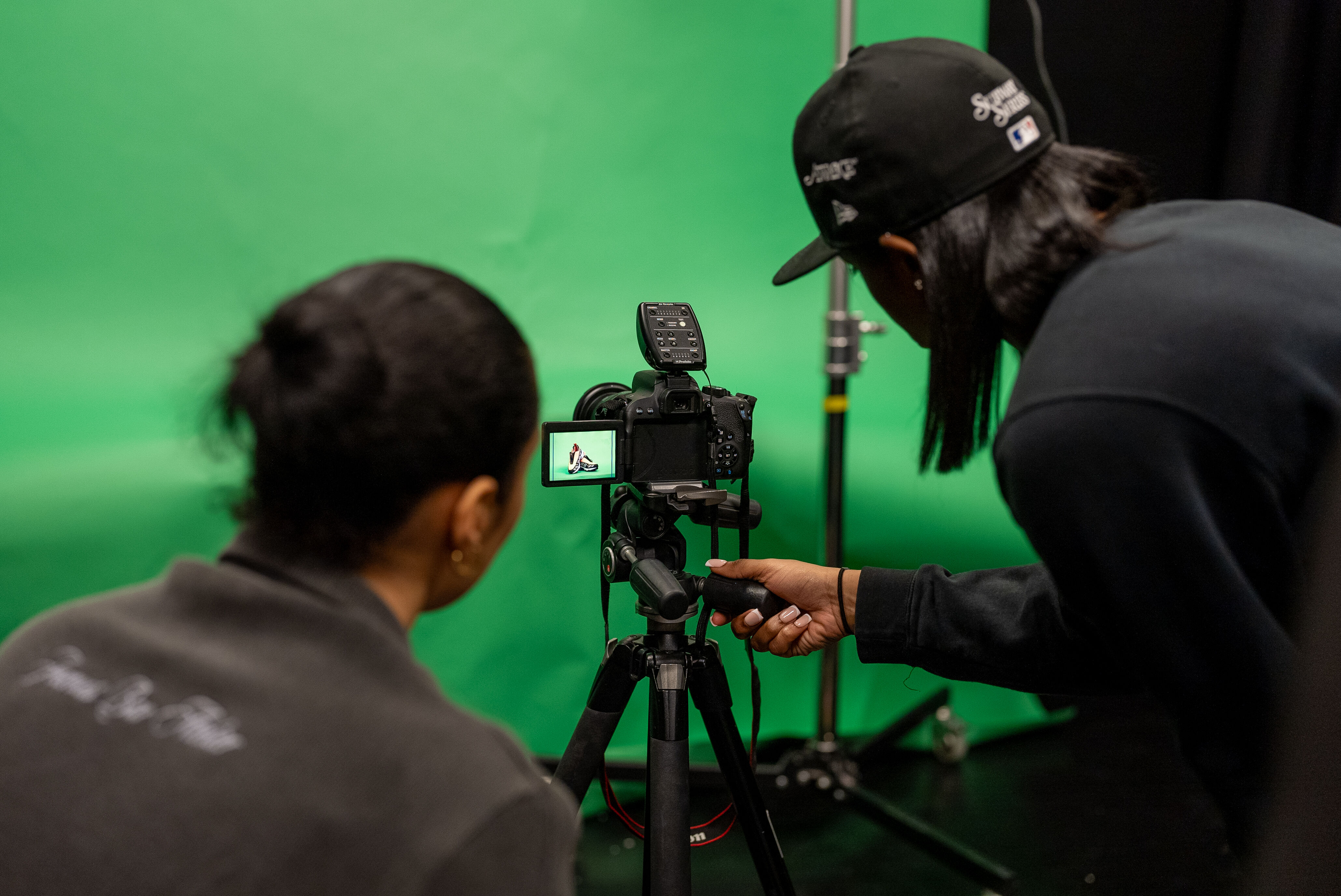We often get asked how students can prepare for their course, so help keep you busy over summer, our Course Directors have put together a list of activities you can do to get ready for September.
Illustration
Course Director: Helen Wheeler
We’d love you to work on something creative in the lead up to joining us. A nice task would be to fill a sketchbook of ideas based around a subject of your choice. Here are some suggestions to try out:
- You could choose an open theme such as ‘people’ or ‘nature’
- Try documenting day to day things a daily walk or commute.
- The content could be purely standalone drawings, or you could try introducing mini narratives if you like to tell stories with your pictures.
- Try to mixing up the media you are using e.g. charcoal, ink, paint, collage, pastel. Maybe try something you’ve never tried before like a dip pen, or even drawing with a stick!
- Give yourself a limited colour palette to work with if you find colour intimidating.
- Remember that your sketchbook is a safe space to play and make mistakes, don’t be too precious!
- Have a look at Illustrators Sketchbooks by Martin Salisbury for some great inspiration!
 What to look at:
What to look at:
You could check out the following websites for up-to-date news on illustration and the Birmingham design scene:
- It’s Nice That
- Behance - https://www.behance.net/galleries/illustration
- The Association of Illustrators - https://theaoi.com
- Birmingham Design - https://birminghamdesign.co.uk
What to read:
If you're interested in reading a book about the rich history of illustration, check out 50 Years of Illustration by Lawrence Zeegan. And if you would like to see how other illustrators develop their drawing skills and process, I would recommend Drawing for Illustration by Martin Salisbury.
Who to follow:
Please follow our course Instagram account @bcuillustration for an insight into the day-to-day goings on for the course!
Layla Sadiq @layla.sadiq.art, Harvey Barber @harbourillustration, Megan Spiers @megspiersillustration, and Spencer Shuttleworth @spenceillustrates are all current students on the course, give them a follow to keep up with their excellent illustration projects and to see how differently all of our students approach their practice.
Graphic Design
Course Director: Jane Anderson
Starting a BA (Hons) Graphic Design course is an exciting step, and preparing over the summer can help you feel confident and ready. Begin by exploring the basics of design principles—contrast, balance, alignment, hierarchy, and typography. Books like “100 Ideas that Changed Graphic Design” by Steven & Veronique Heller or “Thinking with Type” by Ellen Lupton are great starting points.
Build your visual awareness by visiting exhibitions, collecting interesting packaging or posters, and keeping a sketchbook to document your ideas. Practising drawing, even simple observational sketches or layouts, helps develop your eye for composition.
Familiarise yourself with Adobe software like InDesign, Illustrator, and Photoshop and using online tutorials (such as Adobe Learn, YouTube, or LinkedIn Learning). You don’t need to master them, just get comfortable.
 Follow creative studios and designers on platforms like Instagram such as Dixon Baxi, Turner Duckworth, Pentagram, Pearl Fisher, Brands in Motion and SuperUnion to see what work resonates with you. Keep inspired and learn current industry trends. You could also create a Pinterest board of designs that grab your attention and start thinking about why they work.
Follow creative studios and designers on platforms like Instagram such as Dixon Baxi, Turner Duckworth, Pentagram, Pearl Fisher, Brands in Motion and SuperUnion to see what work resonates with you. Keep inspired and learn current industry trends. You could also create a Pinterest board of designs that grab your attention and start thinking about why they work.
Stay curious. Graphic design is about solving problems visually — so ask questions, explore new ideas, and bring your own voice to your work. You'll be amazed how far a bit of summer curiosity can take you.
Finally, follow us on our instagram: https://www.instagram.com/bcu_graphics and we’ll see you in September.
Faculty of Arts, Design and Media
Find out more about our courses
Digital Marketing
Course Director: Gareth Davies
Throughout the duration of the course you will be immersed in real-world, professional advertising and marketing communications. During the summer we run our collaborative practice module in conjunction with the likes of BBC Creative and the British Film Institute.
I thought you might like to have a go at the task last year's students worked on, so if you have some spare time have a go at the following:
Make a three to eight minute video ‘news package’ for BBC News and Current Affairs.
Safely research and report a news story that relates to your own experience of the recent pandemic. As a video journalist you should source appropriate clips, contributors and narration to share as a participant and/or observer. Your content should be in news documentary style, suitable for BBC News or documentary shows on any BBC channel (e.g. Stacey Dooley Investigates on BBC Three or a news bulletin on BBC1) and last no longer than eight minutes in total.

Product Design
Preparing for a product design course requires creative thinking, technical skills and a strong understanding of design principles. There’s a lot of information out there to help you understand a little more about the subject. Design is a dynamic field, and your adaptability and eagerness to learn are pivotal to your success.
What to Read:
Product Design Course Director, Jason Nicholson, has given us his must-reads:
Manufacturing Processes for Design Professionals book by Rob Thompson
This is a great book about production processes; it’s a useful insight into how things are produced across various scales of manufacture. You make a lot of objects on the course, so it’s useful to start investigating how things are made.
Drawing for Product Designers book by Kevin Henry
It’s always useful to practice your drawing skills, and this book covers many visualisation techniques. Maintaining an active drawing practice is equally beneficial; keep a sketchbook and sketch anything that interests you, from natural forms to urban landscapes and the products and furniture that surround you.
Material Matters podcast by Grant Gibson
Take a listen to this series to discover how designers and makers use materials within their own design practice. In parallel, explore sustainability to comprehend the significance of eco-conscious design practices. Familiarise yourself with environmentally friendly materials and design strategies that minimise ecological footprints.
Who to follow:
This is the official course page Instagram. It's a great way to familiarise yourself with the course before you arrive, explore the range and scope of projects and discover the creative influences that inspire our students
Amelia is a current Product Design student; Follow her journey to keep updated on her innovative projects and creative designs.
 What to watch:
What to watch:
Grand Designs available on Channel 4 On Demand
Grand Designs is a British TV series that showcases ambitious and innovative building and renovation projects. Hosted by Kevin McCloud, the show follows homeowners and architects as they embark on extraordinary journeys to design and construct unique and often boundary-pushing, groundbreaking homes.
Abstract: The Art of Design available on Netflix
This inspiring documentary series explores the creative processes of leading designers across various disciplines, offering valuable insights into design thinking, problem-solving, and innovation, making it a valuable watch for you as a product design student, helping you expand your perspective and enhance your design approach.
The Great Pottery Throw Down available on Channel 4 On Demand
The Great Pottery Throw Down is a fun, competitive pottery series where participants, both amateurs and experienced potters, showcase their skills and creativity in crafting intricate ceramic pieces. The show offers a captivating blend of competition and artistic expression, providing a unique and entertaining window into the world of pottery.
Above all, maintain an open mind. Design is a dynamic field, and your adaptability and eagerness to learn are pivotal to your success.
Foundation Year
Course Director: Jo Newman
Using a random word generator enter the first and last letters of the following word: REJUVENATED.
Generate a new word each day and work creatively on a response that lasts between five minutes to two hours long depending on your surroundings and mood!
Anything is possible – you could film, draw, record with narrative, cook, wash, photograph, sculpt, paint etc.
You can document your results in a sketchbook, on random pieces of found papers/surfaces or on a blog – students on the course successfully use Tumblr for online sketchbooks if you would like to give it a try.
For those empty moments where you are looking for something satisfying to do, but are not sure what it is, take a look at this list of ‘things’ to motivate and inspire.
- Watch an art film
- Read CRAFTS – a magazine that’s about more than just traditional crafts!
- Learn more about figure drawing on this blog
